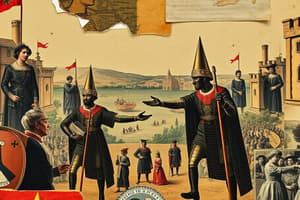Podcast
Questions and Answers
What was the name of the former convent in Paris where the Jacobin club got its name?
What was the name of the former convent in Paris where the Jacobin club got its name?
- St. Jacob (correct)
- St. Michael
- St. Mary
- St. Paul
Who was the leader of the Jacobin club?
Who was the leader of the Jacobin club?
- Louis XVI
- Maximilian Robespierre (correct)
- Napoleon Bonaparte
- George Washington
Why did a large group among the Jacobins decide to wear long striped trousers?
Why did a large group among the Jacobins decide to wear long striped trousers?
- To set themselves apart from the fashionable sections of society (correct)
- To follow the latest fashion trend
- To show their allegiance to the French monarchy
- To show their support for the aristocracy
Which of the following groups were the main members of the Jacobin club?
Which of the following groups were the main members of the Jacobin club?
What is the meaning of the word 'convent' in the context of the chapter?
What is the meaning of the word 'convent' in the context of the chapter?
What was the significance of Fig. 9 in the context of the chapter?
What was the significance of Fig. 9 in the context of the chapter?
What is the significance of Fig. 10 in the context of the chapter?
What is the significance of Fig. 10 in the context of the chapter?
What was the main characteristic of the nobles in the context of the chapter?
What was the main characteristic of the nobles in the context of the chapter?
What was the main occupation of the artisans who were members of the Jacobin club?
What was the main occupation of the artisans who were members of the Jacobin club?
What does the chapter promise to provide more information about in Section 4?
What does the chapter promise to provide more information about in Section 4?
Flashcards are hidden until you start studying
Study Notes
The French Society in the 18th Century
- Peasants were obliged to render services to the lord, including working in their house and fields, serving in the army, and participating in building roads.
- The Church also extracted its share of taxes, known as tithes, from the peasants.
- The third estate, which included peasants, artisans, and women, had to pay taxes to the state, including a direct tax called taille and indirect taxes on everyday consumption items like salt and tobacco.
The Burden of Taxes
- The burden of financing state activities through taxes was borne by the third estate alone.
- Wages did not keep pace with the rise in prices, widening the gap between the poor and the rich.
- This led to a subsistence crisis, where the basic means of livelihood were endangered.
The Estates General
- The Estates General consisted of three estates: the clergy, the nobility, and the third estate.
- The first and second estates sent 300 representatives each, while the third estate had 600 members.
- The third estate was represented by its more prosperous and educated members, while peasants, artisans, and women were denied entry to the assembly.
The Democratic Principles
- The third estate demanded that voting be conducted by the assembly as a whole, where each member would have one vote.
- This was one of the democratic principles put forward by philosophers like Rousseau in his book The Social Contract.
The French Revolution
- In 1792-93, France became a republic, and the king was beheaded.
- In 1804, Napoleon became emperor of France, annexing large parts of Europe.
- In 1815, Napoleon was defeated at Waterloo.
The Jacobin Club
- The Jacobin club was a group of people who belonged mainly to the less prosperous sections of society.
- They included small shopkeepers, artisans, servants, and daily-wage workers.
- Their leader was Maximilian Robespierre, and they wore long striped trousers to set themselves apart from the fashionable sections of society.
The Use of Symbols
- In the 18th century, many people could not read or write, so images and symbols were used to communicate important ideas.
- The painting by Le Barbier uses symbols like the broken chain, the bundle of rods, and the eye within a triangle radiating light to convey the content of the Declaration of Rights.
Studying That Suits You
Use AI to generate personalized quizzes and flashcards to suit your learning preferences.




